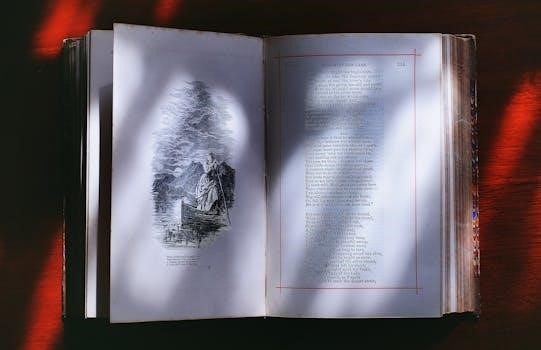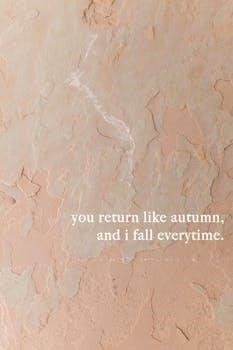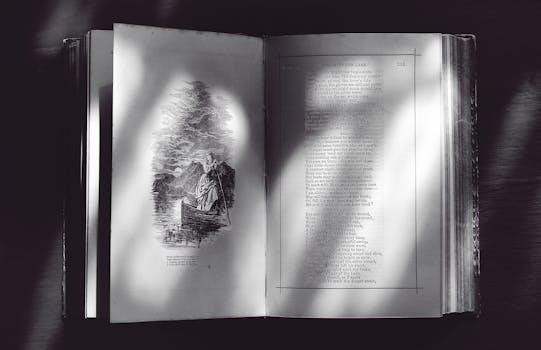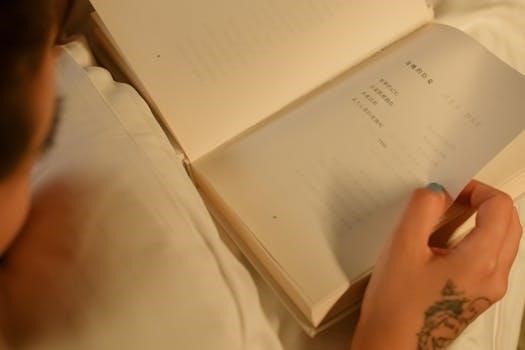Blackout Poetry⁚ A Guide to Printable Texts in PDF Format
Unlock the world of blackout poetry using printable texts in PDF format. Discover accessible resources and tips to maximize potential. Explore examples, sparking creativity for lyrical masterpieces by isolating single words or short phrases from existing texts.
What is Blackout Poetry?
Blackout poetry, also known as erasure poetry, is a unique literary and artistic form where an existing text, such as a book page, newspaper article, or any printed material, is transformed into a new poem by blacking out or obscuring certain words and phrases. The remaining words form the poem, creating a visual and textual piece of art. This process involves carefully selecting words that resonate with the artist’s intended message or theme, while eliminating the rest of the text through various methods like drawing thick lines, using markers, or applying solid blocks of color.
The technique allows for a creative interpretation of the original text, revealing hidden meanings and emotions within the existing words. It’s a blend of poetry and visual art, encouraging randomness and serendipitous discovery as the artist uncovers new narratives within the pre-existing text. Blackout poetry provides a chance to mix poetry and visual art, giving you the chance to express yourself in a unique way.
The Core Concept of Blackout Poetry

The core concept of blackout poetry revolves around transformation and creative reuse. It’s about taking something pre-existing – a page from a book, a newspaper clipping, or any printed text – and reimagining it as something entirely new. The process begins with carefully reading the source text, not for its original meaning, but for the potential words and phrases that can be extracted to create a new narrative. The artist acts as a curator, selecting key words that resonate and piecing them together to form a poem.
The remaining text is then blacked out, visually emphasizing the chosen words and creating a striking contrast between what is revealed and what is concealed. This act of erasure is just as important as the selection of words, as it shapes the visual appearance of the poem and contributes to its overall meaning; Blackout poetry embraces randomness, and gives you a chance to mix poetry and visual art.

Benefits of Using Printable Texts for Blackout Poetry
Printable texts offer numerous benefits for creating blackout poetry. Firstly, they provide a readily available and inexpensive source of material. Instead of sacrificing valuable books or magazines, you can use downloaded and printed pages specifically for this art form. This accessibility makes it easy to experiment and practice without feeling wasteful.

Secondly, printable texts offer a controlled environment for your creative process. You can select texts with specific themes, font styles, or layouts to suit your artistic vision. This level of control is particularly useful for beginners who are still exploring different techniques and styles. Furthermore, printable PDFs can be easily resized, allowing you to work on a scale that is comfortable for you. You can zoom in for detailed work or print multiple copies for different iterations of the same poem. This flexibility enhances the overall creative experience.
Accessibility and Convenience of PDF Resources
PDF resources enhance the accessibility and convenience of blackout poetry. PDFs are universally compatible, opening on any device regardless of the operating system. This widespread accessibility ensures everyone can participate in the art form. Moreover, PDFs are easily shareable, fostering collaboration and community among blackout poetry enthusiasts. You can effortlessly exchange texts and finished pieces, inspiring creativity and learning from others.
The digital nature of PDFs offers organizational benefits. You can store numerous texts on a single device, creating a vast library of potential canvases. Digital storage eliminates the need for physical space and ensures your resources are always readily available. Additionally, PDFs support digital annotation. Before printing, highlight words, make notes, or sketch preliminary designs directly on the PDF. This digital pre-planning streamlines the creation process, allowing for a more efficient and focused approach to blackout poetry.

How to Find Printable Texts for Blackout Poetry PDFs
Finding printable texts for blackout poetry in PDF format is easier than you might think. Start by exploring online repositories. Many websites offer free, downloadable PDFs of classic literature, public domain documents, and creative commons texts. These resources provide a wealth of material suitable for transformation into blackout poetry. Look for websites specializing in educational resources, as they often have downloadable worksheets and excerpts from various texts.
Consider using search engines to your advantage. Use specific keywords like “printable text PDF,” “public domain books PDF,” or “blackout poetry resources.” Refine your search by adding genre preferences, such as “Victorian novels PDF” or “science articles PDF.” Don’t overlook online libraries and archives. Project Gutenberg, for example, offers a vast collection of free e-books in PDF format. Explore government websites and university archives for historical documents and reports.
Searching Online Repositories
When diving into online repositories for blackout poetry texts, a strategic approach is essential. Begin with well-known sources like Project Gutenberg and Internet Archive, which host vast collections of digitized books and documents. Use their search functions effectively, employing keywords related to genre, author, or historical period to narrow down your options. Many online repositories offer advanced search features, allowing you to filter results by file type (specifically PDF) and publication date.
Explore smaller, specialized online archives that cater to specific interests. For instance, websites dedicated to historical newspapers or scientific journals can provide unique and intriguing source material. Remember to check the licensing terms of each text before downloading. Ensure that the material is in the public domain or available under a Creative Commons license that permits modification for artistic purposes. These repositories can be treasure troves for unique and compelling blackout poetry projects.
Tips for Selecting the Right Printable Text
Choosing the right printable text is crucial for successful blackout poetry. Begin by considering the overall theme or message you want to convey. Select a text that resonates with this theme, whether it’s a classic novel, a scientific paper, or even a discarded instruction manual. Skim through the text, paying attention to recurring words, striking phrases, and the general tone. A text with a diverse vocabulary and varied sentence structure will offer more creative possibilities.
Think about the visual appeal of the page itself. A page with interesting typography or unique layout can enhance the final artwork. Avoid texts that are too dense or cluttered, as they can be overwhelming to work with. Look for texts with ample white space, allowing room for visual elements and creative blackouts. Ultimately, the best text is one that inspires you and sparks your imagination, leading to a unique and meaningful piece of blackout poetry.
Considering Text Density and Font Style
Text density and font style significantly impact the blackout poetry creation process. Dense text, packed with words and minimal spacing, presents a challenge. While it offers a greater selection of words, it can be visually overwhelming and make isolating key terms difficult. Conversely, sparse text might limit word choices, but it provides ample space for artistic expression through blackouts and visuals. The ideal density depends on your artistic style and desired outcome.
Font style also plays a crucial role. A clean, readable font, like Times New Roman or Arial, is generally easier to work with, especially for beginners. More decorative fonts can add character, but may also make the text harder to scan and manipulate. Consider how the font’s aesthetic will complement the overall theme and visual design of your blackout poem. Experiment with different densities and styles to discover what works best for your creative vision.
Step-by-Step Guide to Creating Blackout Poetry with PDFs
Creating blackout poetry with PDFs is an accessible and engaging process. First, select a suitable PDF text. Old articles, book pages, or even legal documents can serve as excellent raw material. Print the PDF page you wish to transform. Begin by carefully reading the entire text to grasp its overall context and identify potential keywords that resonate with you.
Next, lightly circle or highlight the words that you want to incorporate into your poem. Consider themes, emotions, or a narrative you wish to convey. Don’t be afraid to experiment and let the text guide your creative process. Once you’re satisfied with your selection, use a thick black marker to completely black out the remaining text, leaving only your chosen words visible. Finally, add visual elements like lines, shapes, or drawings to enhance the poem’s aesthetic and further express your artistic vision.
Scanning and Highlighting Key Words
The initial step in creating blackout poetry involves carefully scanning your chosen printable text PDF. The goal is to identify striking words or phrases that resonate with you or align with a particular theme you wish to explore. Look for words that evoke strong emotions, spark your curiosity, or stand out due to their uniqueness.
As you scan, lightly circle or highlight these potential keywords. Don’t be afraid to mark more words than you think you’ll need; it’s always better to have options. Consider how different words might connect to form a cohesive narrative or express a specific feeling. Pay attention to words that repeat or stand out from the surrounding text, as these can often serve as powerful anchors for your poem. Remember to let the text guide you, and trust your intuition as you uncover hidden meanings and connections within the original source material.
Blacking Out Unwanted Text and Creating Visuals
Once you’ve identified and highlighted your key words, the next step is to black out the remaining text on the page. This is where the magic truly happens, as you transform the original text into a unique work of art. Using a thick black marker, carefully cover all the words you don’t want to include in your poem. Ensure the ink is opaque, completely obscuring the unwanted text.
As you black out the text, consider the visual impact of your choices. Think about how the remaining white space and the arrangement of the keywords will contribute to the overall aesthetic of your poem. Don’t be afraid to incorporate visual elements into your blackout. You can create patterns, shapes, or images around your words, adding another layer of meaning and artistic expression. Experiment with different techniques, such as leaving small gaps of white space or creating intricate designs with the black marker.
Examples of Printable Texts Suitable for Blackout Poetry
The beauty of blackout poetry lies in its adaptability; almost any printable text can be transformed into a unique work of art. However, some texts lend themselves particularly well to this creative process. Excerpts from classic literature, with their rich vocabulary and evocative imagery, are an excellent choice. Consider using pages from novels, poems, or even plays to create your blackout poems. The density of the text and the varied sentence structures can provide a wealth of inspiration.
Old newspapers and magazines are another fantastic source of printable texts. The diverse range of topics and writing styles can spark unexpected connections and lead to surprising results. You can also explore using excerpts from historical documents, scientific articles, or even instruction manuals. The key is to choose texts that resonate with you and offer a variety of words and phrases that you can manipulate to create your own unique message.
